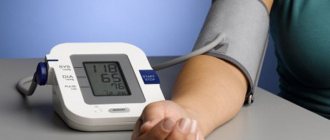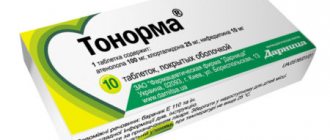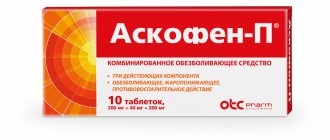Tenoric®
General precautions for atenolol and chlorthalidone
Renal dysfunction
Caution should be exercised when prescribing the drug to patients with renal failure. In patients with impaired renal function, Tenoric® should be prescribed after titrating the dose of the individual components of the drug, taking into account the degree of reduction in glomerular filtration rate.
Thiazide and thiazide-like diuretics may cause azotemia in patients with impaired renal function. Like other thiazide-like diuretics, chlorthalidone is ineffective when creatinine clearance is less than 30 ml/min.
Elderly age
In elderly patients, the drug should be used with extreme caution due to changes in the pharmacokinetics of both active substances.
In case of increasing bradycardia, arterial hypotension, atrioventricular block, bronchospasm, ventricular arrhythmias, severe liver and kidney dysfunction in elderly patients, it is necessary to reduce the dose or stop treatment.
In elderly patients, it is recommended to regularly monitor renal function (at least once every 4-5 months).
In patients with severe atherosclerosis of the cerebral and coronary arteries, the drug should be used with extreme caution due to the risk of severe arterial hypotension.
Other
The drug Tenoric® should not be used to relieve a hypertensive crisis.
The use of Tenoric® in patients with acute myocardial infarction is not recommended due to insufficient experience in clinical use.
Atenolol
Discontinuation of therapy and “oricochete syndrome” of arterial hypertension).
Medicines that deplete catecholamine stores (for example, reserpine or guanethidine) may enhance the effect of beta-blockers. Therefore, patients taking such combinations of drugs should be under constant medical supervision to detect a significant decrease in blood pressure or bradycardia.
Laboratory research
Atenolol should be discontinued before testing the content of catecholamines, normetanephrine and vanillylmandelic acid in the blood and urine, as well as the titer of antinuclear antibodies in the blood.
Chlorthalidone
Liver dysfunction
When using thiazide and thiazide-like diuretics in patients with impaired liver function, hepatic encephalopathy may develop.
In patients with severe liver failure or hepatic encephalopathy, the use of the drug is contraindicated.
In patients with mild to moderate hepatic impairment and/or progressive liver disease, the drug should be used with caution, since even a slight change in water and electrolyte balance can cause hepatic coma.
Water-electrolyte balance and metabolic disorders
Potassium
Hypokalemia may occur when taking thiazide and thiazide-like diuretics. Hypokalemia increases the risk of developing heart rhythm disturbances (including severe arrhythmias). In patients taking cardiac glycosides, hypokalemia increases the toxic effects of the latter and may predispose to cardiac arrhythmias.
Potassium levels should be regularly monitored, especially in elderly patients, in patients taking cardiac glycosides for the treatment of chronic heart failure, in patients with an unbalanced diet (foods low in potassium) or in patients with complaints of gastrointestinal disorders (vomiting, diarrhea). If hypokalemia occurs, appropriate treatment should be prescribed.
Sodium
Like other diuretics, chlorthalidone can rarely cause hyponatremia, sometimes leading to serious complications.
Calcium
Thiazide and thiazide-like diuretics can reduce the excretion of calcium ions by the kidneys, leading to a slight and temporary increase in calcium levels in the blood plasma. In some patients, with long-term use of diuretics, pathological changes in the parathyroid glands with hypercalcemia and hyperphosphatemia were observed, but without the typical complications of hyperparathyroidism (nephrolithiasis, decreased bone mineral density, peptic ulcer). Severe hypercalcemia may be a manifestation of previously undiagnosed hyperparathyroidism.
Because of their effect on calcium metabolism, thiazide and thiazide-like diuretics may affect laboratory parameters of parathyroid function. You should stop taking the drug before testing the function of the parathyroid glands.
Glucose
Impaired glucose tolerance may occur. Caution should be exercised if the drug is used in patients with a known predisposition to diabetes mellitus.
Uric acid
Hyperuricemia may occur when taking the drug. Usually there is only a slight increase in serum uric acid concentrations, but in some cases the use of uric acid detoxifying agents may be necessary.
In patients with gout, taking the drug may increase the frequency of attacks or worsen the course of gout. Careful monitoring of patients with gout and impaired uric acid metabolism (hyperurecemia) is necessary.
Lipids
With long-term use of thiazide and thiazide-like diuretics, the concentration of total cholesterol, low-density lipoprotein cholesterol and triglycerides in the blood plasma may increase.
Immune system disorder
There are reports that thiazide and thiazide-like diuretics may cause exacerbation or progression of systemic lupus erythematosus, as well as lupus-like reactions.
In patients receiving thiazide-like diuretics (including chlorthalidone), hypersensitivity reactions may occur even in the absence of a history of allergic reactions or asthma.
Photosensitivity
Cases of the development of photosensitivity reactions when taking thiazide and thiazide-like diuretics have been described. If photosensitivity occurs while taking the drug, treatment should be discontinued. If continued use of the drug is necessary, the skin should be protected from exposure to sunlight or artificial ultraviolet rays.
Description of the drug TENORIK
Slow calcium channel blockers (SCBs, e.g. verapamil, diltiazem)
- increased negative inotropic effect of atenolol, especially in patients with reduced myocardial contractility and/or with impaired sinoatrial or AV conduction. This may lead to the development of severe hypotension, bradycardia or heart failure. Slow calcium channel blockers should not be used intravenously within 48 hours after discontinuation of beta-blockers.
Class I antiarrhythmic drugs (disopyramide) and amiodarone
- it is possible to increase the atrial conduction time and enhance the negative inotropic effect of atenolol; the cardiodepressive effect may be additive.
Norepinephrine (norepinephrine), epinephrine (adrenaline)
- possible significant increase in blood pressure
Cardiac glycosides, reserpine, alpha-methyldopa, guanfacine or clonidine
- due to the possible appearance of potassium and/or magnesium deficiency in connection with taking this combination of beta-blockers, the sensitivity of the heart muscle to cardiac glycosides may increase, and, accordingly, the frequency of their side effects may increase.
Clonidine
- Abrupt withdrawal of clonidine can lead to an increase in blood pressure, so discontinuation of clonidine should be done gradually and only a few days after discontinuation of beta-blockers.
Tricyclic antidepressants, barbiturates, phenothiazines, diuretics, vasodilators and other antihypertensive drugs, ethanol
- the antihypertensive effect may be enhanced.
ACE inhibitors (captopril, enalapril)
- at the beginning of therapy, a sharp increase in the antihypertensive effect of the drug is possible.
Salicylates and other NSAIDs
- a decrease in the antihypertensive effect of beta-blockers is possible, and with a high dose of salicylates - an increase in the toxic effect of salicylates on the central nervous system. With simultaneous use of this combination with NSAIDs, the diuretic and hypotensive effects may be weakened.
Lithium
- decreased excretion of lithium and increased cardio- and neurotoxic effect of lithium.
Curare-like muscle relaxants (tubocurarine)
- it is possible to strengthen or weaken the neuromuscular blockade.
GCS, carbenoxolone, amphotericin B, furosemide
- it is possible to increase the excretion of potassium ions.
Allopurinol
- may increase the incidence of hypersensitivity reactions to chlorthalidone.
Lorthalidone may increase the risk of adverse reactions due to amaptadine.
Anticholinergic drugs (eg, atropine, biperiden) may increase the bioavailability of chlorthalidone, reducing gastrointestinal motility and gastric emptying.
The pharmacological effects of calcium salts and vitamin D may be increased to clinically significant levels when used concomitantly with chlorthalidone.
Concomitant use with cyclosporine increases the risk of developing hyperuricemia and complications such as gout.
Cholestyramine interferes with the absorption of chlorthalidone (the pharmacological effect of chlorthalidone may be reduced).
The simultaneous use of chlorthalidone with methotrexate and cyclophosphamide can lead to potentiation of the pharmacological effect of anticancer drugs. Interactions caused by the combination of chlorthalidone and atenolol, which are part of the drug Atenolol compositum San dose*.
Insulin and hypoglycemic agents for oral administration, the effect of the latter may be enhanced. It is necessary to regularly monitor the concentration of glucose in the blood, since signs of hypoglycemia (tremor, tachycardia) may be masked or weakened by taking Atenolol compositum Sandozk
Drugs for general anesthesia: enhancing the antihypertensive effect and summing up the negative inotropic effect of both drugs. Slow calcium channel blockers (SCBs), dihydropyridine derivatives (for example, nifedipine): the risk of arterial hypotension may increase; in patients with latent heart failure, signs of circulatory disorders may appear . Baclofen: may enhance antihypertensive effect
Tenoric
The drug tenoric from the Indian pharmaceutical is a combination drug that has a long-term antihypertensive effect. Such a pronounced effect is due to the coordinated work of two pharmacologically active components: the beta-1 adrenergic blocker atenolol and the diuretic chlorthalidone.
Arterial hypertension is the most common cardiovascular disease in Russia, with which at least 40% of the entire population of the country are familiar to one degree or another. In this regard, the problem of adequate antihypertensive pharmacotherapy becomes particularly important. Clinicians are constantly searching for the most effective drugs and their combinations that can overcome the cardiovascular “epidemic”. Combinations of beta-blockers with diuretics are among the “oldest” and most studied. Among such pharmacological combinations, the drug tenoric occupies a prominent place on Russian pharmacy shelves. According to a pharmacoepidemiological study of patients suffering from arterial hypertension, conducted by scientists from the Russian State Medical University and the Research Institute of Cardiology, among all combined antihypertensive drugs, tenoric is one of the most affordable.
As already mentioned, the drug contains two active ingredients. Atenolol, a cardioselective beta-blocker, reduces the force of heart contractions and slows their frequency. Increasing the dose causes a decrease in the selectivity of the substance. Atenolol does not have internal sympathomimetic activity or membrane-stabilizing effect. The sulfonamide diuretic chlorthalidone promotes the excretion of sodium, chlorine, potassium and magnesium from the body. For the manifestation of the antihypertensive effect, the removal of the first is clinically significant. The therapeutic effect of tenorik after a single dose of the recommended dose lasts for 24 hours.
As the results of clinical studies have shown, the use of tenoric in patients with arterial hypertension led to an improvement in the clinical situation to a greater extent compared with taking atenolol alone or the sulfonamide diuretic indapamide. Tenoric reliably controlled blood pressure both during the day and at night, while atenolol controlled blood pressure only during the day.
Tenoric is available in tablets. The average daily dose of the drug in terms of atenolol is 100 mg; treatment is usually started with a dose of 50 mg. As practice has shown, increasing the dose of tenoric above 100 mg did not lead to a more pronounced decrease in blood pressure, therefore, if it is necessary to enhance the therapeutic effect, you can additionally include another antihypertensive drug from a different group in the pharmacotherapeutic course. Elderly patients should take lower doses of tenoric, and patients with renal failure should reduce the frequency of its use. After long-term drug courses, drug withdrawal is carried out smoothly, excluding abrupt cessation of use. It should be borne in mind that treatment with tenoric may mask conditions caused by excessive secretion of thyroid hormones and hypoglycemia. In smokers, the severity of the therapeutic effect of the drug is usually reduced. While taking tenoric, sensitization to allergens may develop, resulting in severe anaphylactic reactions. Atenolol, which is part of the drug, can reduce the secretion of tear fluid - this should be taken into account in patients who use contact lenses. Due to the possible impairment of glucose tolerance caused by chlorthalidone, tenoric should be used with caution in patients with diabetes mellitus.



